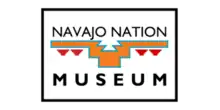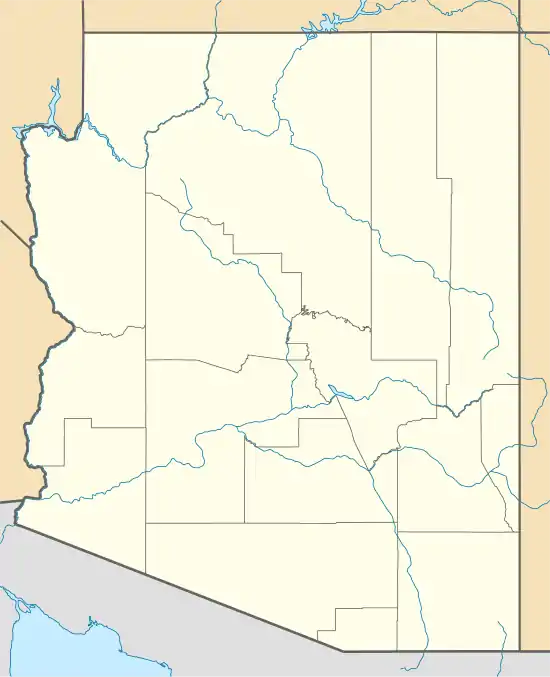 | |
 Location within Arizona | |
| Established | 1961 |
|---|---|
| Location | Highway 264 and Loop Road Window Rock, Arizona 86515 |
| Coordinates | 35°39′51″N 109°03′12″W / 35.6641795°N 109.0531972°W |
| Type | Ethnographic, archaeological, art |
| Website | navajopeople |
The Navajo Nation Museum is a museum and library on Navajo ground in Window Rock, Arizona. Its collections, exhibits, and other activities focus on the cultural history of the Navajo people. Its activities include traditional museum exhibits, a research library, and programs that help to revive and preserve the Navajo language.
Facilities
The museum is located in a modern building in Window Rock, Arizona, the capital of the Navajo Nation,[1] next to the Navajo Zoo. It is in the approximate center of a 27,000-square-mile (70,000 km2) Navajo reservation, about 500 yards (0.46 km) west of Arizona's border with New Mexico.
The museum building – officially named the Navajo Nation Museum, Library & Visitor's Center[2] – also houses the Navajo Nation Library, home to five special collections that support historical, legal, cultural and governmental research.[3] The building is surrounded by the area's typical sandstone cliffs. A trailhead begins outside, leading to an overlook of the reservation.[2]
The current building is the product of a long development process. A Navajo Tribal Museum was established in 1961 in a small building on the Window Rock Tribal Fairgrounds. In 1982, it moved to the backroom of an arts and crafts store. In 1997, the current building was constructed at a cost of $7 million.[4]
Collections and exhibits
The museum collects items that help to document the culture and history of the Navajo people, including selected materials from tribal and non-Indian neighbors. Its extensive holdings include artistic, ethnographic, archaeological, and archival materials. These include over 40,000 photographs and a wide variety of documents, recordings, motion picture film, and videos. The archives are heavily used by authors, researchers, and publishers as a source for historical photographs. Most of the collections are available for on-site study and exhibit loan.[5]
The museum maintains an active and professional exhibits program, most of which is produced in-house. Exhibits tend to highlight the work of Navajo artists in various media, including weavings. These art-oriented exhibitions are interspersed with historical and cultural exhibits. A comprehensive, large-scale, long-term exhibition on Navajo culture and history is currently being researched and scripted.[5]
Current exhibits include an interpretive video and photographs, artwork, jewelry, and textiles relating to the history and culture of the Navajo people. One describes the arduous 1864 ordeal known as the Long Walk of the Navajo, in which the Navajo were removed from tribal lands and marched some 300 miles to a prison camp in Fort Sumner, New Mexico.[1][2][6]
Another one would be titled Jo' Jini'–If These Objects Could Talk. Medicine men who share traditional Navajo teachings often end each pronouncement by saying "jó jiní" ("that's what I heard" or "it was said"). The exhibit features 60 items, including jewelry, folk art, pottery, historical items and contemporary pieces, contributed by 25 different donors. One such donated piece includes a flag that was flown at Fort Sumner.[7]
In 2018 the National Archives loaned the museum the only copy of the 1868 treaty that created the Navajo reservation and ended the incarceration of the Navajo at Fort Sumner. A second copy later surfaced at the home of Samuel F. Tappan, a member of the Indian Peace Commission who had helped to draft the treaty. That copy went to the Bosque Redondo memorial for the anniversary of the treaty's signing. A third copy is thought to have been buried with Barboncito.[8]
The exhibits are supplemented by items in the museum's gift shop, which offers books about Navajo culture, jewelry, and other items in the museum's collections.[6]
Other activities
The museum and its director Manuelito Wheeler (Navajo) have a great interest in reviving and preserving the Navajo language, and in making it accessible to a greater number of Navajos. They worked with LucasFilm to create a Navajo-dubbed version of Star Wars: Episode IV – A New Hope; the project was completed in 2013. In 2015 they spent a full year collaborating with Pixar on a Navajo-language version of Finding Nemo. Great care was taken in selecting Navajo voice actors and in producing linguistically accurate dubbing. The film, Nemo Hádéést'íí, premiered in Albuquerque in 2016 and played in select cities throughout the southwest. It was very well received by Navajo audiences.[9]
Wheeler has presented academic lectures on Navajo subjects, including "Navajo Identity through Global Projects." Under his direction, the museum worked with world-renowned artist Ai Weiwei, partnering him with Navajo artist Bert Benally to create a site-specific installation piece in a remote canyon on the Navajo Nation.[10][11]
References
- 1 2 "Navajo Nation Museum". AAA website. American Automobile Association. Archived from the original on 2017-03-08. Retrieved 2017-03-07.
- 1 2 3 Ellis, Katherine (2017-01-11). "A visit to the Navajo Nation Museum". Next Generation Radio @ KJZZ website. Tempe, Arizona: KJZZ (FM). Archived from the original on 2017-03-08. Retrieved 2017-03-07.
- ↑ "Navajo Nation Library". Navajo Nation Library website. Navajo Nation Council. Archived from the original on 2017-05-10. Retrieved 2017-03-07.
- ↑ Lapahie, Harrison Jr. "Window Rock, Arizona". Harrison Lapahie website. Archived from the original on 2006-06-23. Retrieved 2017-03-07.
- 1 2 "Navajo Nation Museum". Navajo Nation Museum website, various pages. Navajo Nation Museum. Archived from the original on 2017-03-08. Retrieved 2017-03-07.
- 1 2 "Navajo Nation Museum". Arizona Tourism website. Arizona Office of Tourism. Archived from the original on 2017-03-08. Retrieved 2017-03-07.
- ↑ ADI News Services (2016-01-12). "Navajo Nation Museum to Feature Unique Exhibit Called Jo'Jini'". Arizona Daily Independent. Arizona Daily Independent. Archived from the original on 2017-03-08. Retrieved 2017-03-07.
- ↑ Cindy Yurth (December 27, 2018). "2018: Year of Schism". Navajo Times. p. A1.
- ↑ Long, Levi (2016). "Finding Nemo Finds Its Voice - in Navajo". Native Peoples Magazine. Archived from the original on 2017-03-08. Retrieved 2017-03-07.
- ↑ "Indigenous Lecture by Manuelito Wheeler, Navajo Nation Museum Director". Department of English website. Arizona State University. 2016-03-24. Archived from the original on 2017-03-08. Retrieved 2017-03-07.
- ↑ Olsen, Caitlin (2015-01-21). "Cultural Landscapes: Ai Weiwei and Bert Benally". Public Art Review (51). Archived from the original on 2017-03-08. Retrieved 2017-03-07.